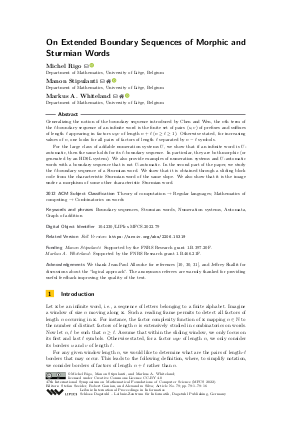@InProceedings{rigo_et_al:LIPIcs.MFCS.2022.79,
author = {Rigo, Michel and Stipulanti, Manon and Whiteland, Markus A.},
title = {{On Extended Boundary Sequences of Morphic and Sturmian Words}},
booktitle = {47th International Symposium on Mathematical Foundations of Computer Science (MFCS 2022)},
pages = {79:1--79:16},
series = {Leibniz International Proceedings in Informatics (LIPIcs)},
ISBN = {978-3-95977-256-3},
ISSN = {1868-8969},
year = {2022},
volume = {241},
editor = {Szeider, Stefan and Ganian, Robert and Silva, Alexandra},
publisher = {Schloss Dagstuhl -- Leibniz-Zentrum f{\"u}r Informatik},
address = {Dagstuhl, Germany},
URL = {https://drops.dagstuhl.de/entities/document/10.4230/LIPIcs.MFCS.2022.79},
URN = {urn:nbn:de:0030-drops-168776},
doi = {10.4230/LIPIcs.MFCS.2022.79},
annote = {Keywords: Boundary sequences, Sturmian words, Numeration systems, Automata, Graph of addition}
}

 Creative Commons Attribution 4.0 International license
Creative Commons Attribution 4.0 International license







